Dumpy tree frogs get their name “dumpy” from their short and chubby appearance. The “tree frog” comes from their tree-dwelling lifestyle.
The frogs also go by the name White’s tree frogs in respect to explorer John White who first described them.
Besides the stocky build, these frogs have a bright green skin coloration and piercing eyes that you would think are seeing straight into your soul!
These frogs are described as quiet, gentle, and laidback animals and are pets for frog enthusiasts all over the world.
Native to Indonesia, Australia, and Papua, New Guinea, these cute and cuddly frog species play a crucial role in their ecosystems as both prey and predators.
They also act as indicator species as they are highly sensitive to changes in their environments.
Unfortunately, they face threats commonly faced by their relatives such as habitat loss, climate change, pollution, etc., which can threaten their existence.
For this reason, it is important to study the Dumpy tree frog habitat and behavior and come up with conservation measures to protect its wild populations.
In this article, we have discussed everything you need to know about dumpy tree frogs, including their physical characteristics, habitat, behavior, and conservation status.
We have also discussed their unique adaptations, mating rituals, and other interesting facts you did not know about them.
Species name:
- Common name: Dumpy Tree Frog, White’s tree frog, Smiling Frog
- Scientific name: Litoria caerulea
Classification:
- Family: Hylidae
- Genus: Litoria
- Species: caerulea
Physical Characteristics
Dumpy tree frogs are quite big, with an adult’s average size being 3 to 4.5 inches (or 7 to 11.5 cm) from snout to vent. Females usually grow bigger than males.
Mind you, these frogs are some of the largest frog species in Australia.
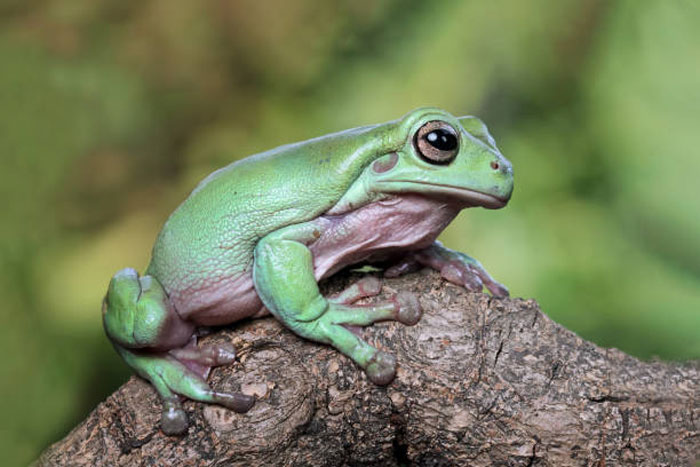
Most pet owners love this for its facial expression, including a smiling mouth and eyes that look sleepy.
The frogs have horizontal pupils, unlike other tree frogs that usually feature vertical pupils. They have big golden/yellow eyes and a black ring surrounding the edge of the eyes.
Other notable features include a grove that runs along their backs and a slightly pointed nose.
Coloration and markings:
The coloration of these frogs ranges from emerald green to light blue or gray on their backs. They may also feature shades of grey-blue and purpose. They may also bear irregular white spots on their backs.
Their underbellies are usually milky white. Females are easily distinguishable from males with their white throats. Male vocal sacs are grayish and wrinkled and sit underneath the throat.

Just as with the other tree frogs, the white’s tree frogs are capable of changing their body color to some degree. This explains why the frogs sometimes appear brown or have white spots on its back.
Overall, most owners have noted that the frog coloration is darker and browner when the temperature gets low. When the temperature is high and humidity is low, they appear brighter and blue.
The skin of dumpy tree frogs is smooth though it may appear folded due to the chubby nature of these animals.
Different Dumpy tree frog species:
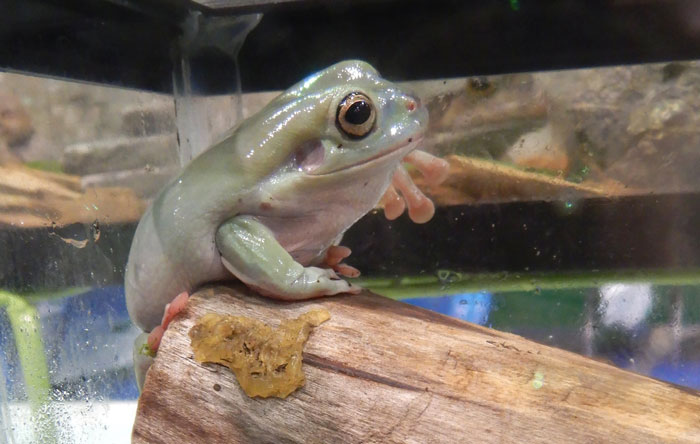
Species that fall under the genus Litoria are considered the closest relatives of the dumpy tree frogs and include:
- Southern Bell Frog (Litoria raniformis): This frog is smaller than the other species and grows to a maximum of 2.5 inches. It has bright green coloration and has black spots. It inhabits southeastern Australia.
- Giant tree frog (Litoria infrafrenata): This frog can grow to a maximum length of 4.5 inches. It has molten green-to-brown coloration that enables it to blend with its habitat in Solomon Islands and New Guinea.
- Golden Bell Frog (Litoria aurea): it can reach up to 4.5 inches and is a ground-dwelling species native to eastern Australia. It has a striking green coloration with golden or bronze markings throughout its body.
Unique Adaptations:

These frogs have developed some morphological adaptations that enable them to survive in their habitats as discussed below:
- Enormous toe pads: These toes have adhesive surfaces that enable them to cling to leaves and branches in the wild, even in wet weather, making the good climbers. The toes also have some webbing that allows them to glide and make big lips between tree branches.
- Waxy skin coating: Its skin is coated with a waxy substance that enables the frog to survive in arid environments that the common treefrog species can’t tolerate.
- Loose and rubber skin: This unique adaptation enables the frogs to absorb as much water as possible. This further enables them to tolerate dry conditions.
- Binocular vision: Their large eyes and nostrils sit on the head to form a binocular vision. This enables the frog to look out for food and predators when sitting in water or with the rest of its body submerged in water.
Other unique adaptations include color camouflage capabilities and powerful jumps that enable them to avoid predation.
Habitat and Behavior
Dumpy tree frogs are native to Indonesia, New Guinea, and Australia (they are widely distributed here, especially in the east and northern parts). However, the species has also been introduced to New Zealand and Florida.
These frogs are highly adaptable to different environments. This explains why they occur in a wide range of habitats ranging from coastal to arid habitats, rainforest ecosystems, etc.
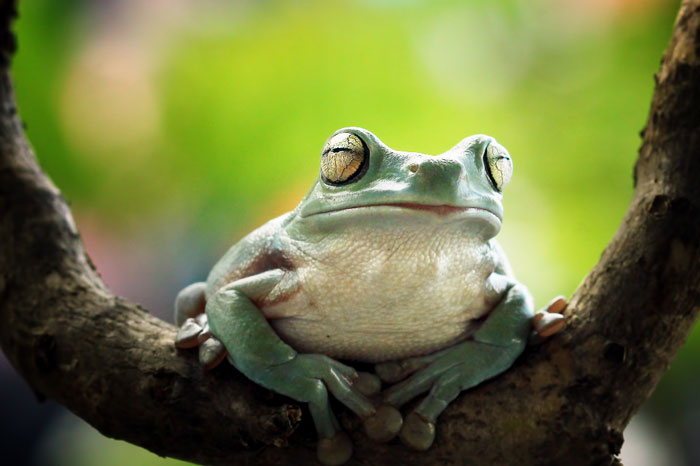
Generally, these frogs are arboreal (tree-dwellers) and prefer living in tree canopies near ponds and other still waters.
However, you will also find them in woodlands, grasslands, rock crevices, near streams, and swamps. You can even find them in hollow tree trunks!
In New Guinea, the White’s tree frogs usually inhabit the open monsoon forests as well as human dwellings, including gardens.
Social and nocturnal behavior:
Dumpy tree frogs are social and friendly to each other. They also show nocturnal behavior, where they are mostly active at night when they forage for food. During the day, the frogs prefer resting and hiding in dark, cool, and moist areas.
Vocalizations:
Dumpy tree frogs use vocalizations to communicate with each other.
Besides the usual mating calls, these frogs also tend to make calls to advertise their locations, especially after rain. However, the reason for this is still unclear to research institutions.
They also make ear-piercing calls when in danger, e.g. when a predator is close to them or if a human step on or comes close to the log they are hiding in.
Mating and breeding:
White’s tree frogs reach sexual maturity around the age of 2 years. Mating rituals start in early October; males usually females from high points like trees and gutters.
Breeding season occurs from November to February. During this period, females that respond to the mating calls meet their mates in still and shallow waters (this is where the mating event occurs).
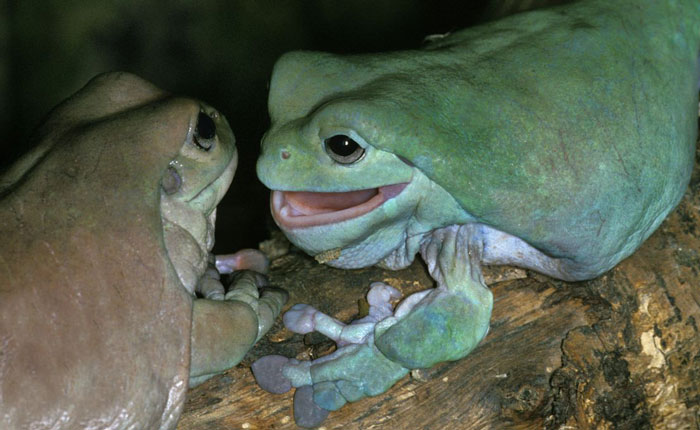
During the event, the mating pair stay in the amplexus position for up to 48 hours (2 days). The female rapidly releases between 200 and 300 eggs, which the males fertilize as they are ejected.
Throughout the amplexus period, a female would have released thousands of eggs (between 2000 and 3000 eggs!).
The eggs are usually brown in color and range from 1.1 to 1.4mm in diameter. They come out while encased in jelly. They are eventually deposited on the still water surface.
Development:
The dumpy frog’s eggs hatch in just 3 days, provided the temperature and water depth are suitable. The tadpoles feature molten brown appearance when hatched.

Tadpoles live in water where they are primarily omnivores feeding on algae, drowned insects, mosquito larvae, etc.
They take approx. 2 months to metamorphose into froglets. Adult frogs do not give any form of parental care to tadpoles.
Feeding habits and predation
Adult dumpy tree frogs are primarily insectiv犀利士 ores and feed on a wide range of insects in their habits including mosquitoes, grasshoppers, flies, beetles, moths, spiders, etc.
They have also been observed feeding on small mammals.
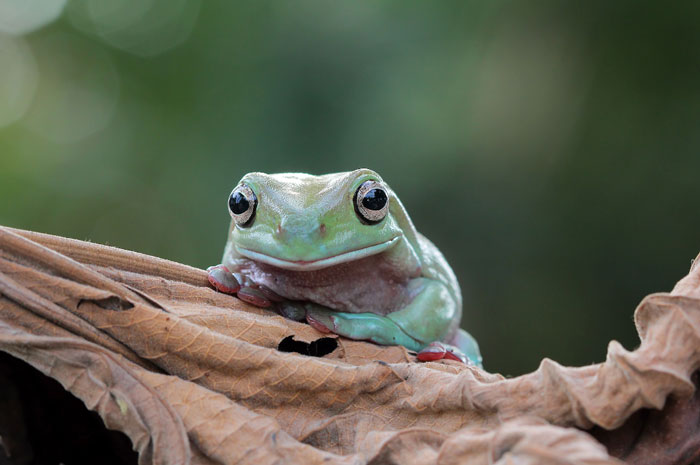
If the frogs are dealing with small prey, they usually propel their extensive tongues to capture it on their sticky tongue. As for larger prey, they use their hands to seize it and then force it down their throats.
Native predators of these tree frogs include birds, snakes, and lizards. Dogs and cats also prey on those that live in urban and suburban areas.
Conservation Status
Dumpy tree frogs are classified as species of Least Concern (LC) by the IUCN. This means these frogs are not threatened.
However, we cannot overlook the fact that these frogs continue to face many threats in the wild. These greatly affect their populations and they may become endangered species soon.
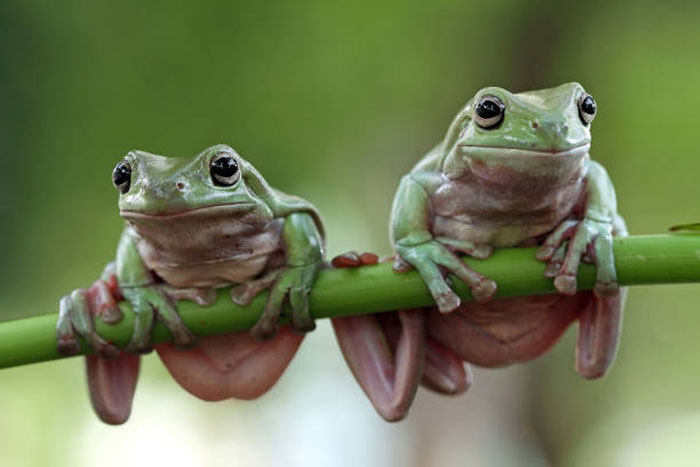
Some of the most common threats these unique frogs face include:
- Habitat loss: Urbanization along coastal areas where these frogs live leaves them homeless. Other human activities causing the loss of habitats for these frogs include roads and railways constrictions, ranching, farming, fishing, etc.
- Pollution: Like other amphibians, these frogs have highly permeable skins that easily take in toxins and other pollutants in their habitat. This can increase their mortality rates and make their decline in the future. Since these frogs act as indicator species, their population decline could be a sign that their ecosystems are polluted/unhealthy.
- Pet trade: High demand for these frogs as pets means they are collected in the wild for the pet trade. However, taking them from their natural habitats may end up significantly affecting their wild populations.
- Emerging diseases: These frogs are among the species attacked by the infectious fungal disease Chytrid fungus. This disease is likely to turn into an epidemic in the near future that severely affects the amphibian populations in the wild.
Conservation efforts to protect dumpy tree frogs:
Conservation organizations have come up with various Dumpy tree frog conservation efforts to help protect the frog populations.
One such effort is increased study and research into Dumpy tree frog behavior and ecology. These studies help come up with more effective strategies for protecting them and their habitats.
Another strategy involves preserving and restoring the frog habitats. This can be achieved by creating reserves, national parks, and other protected areas. Sustainable land use practices will also help prevent the loss of frog ecology and resources in them which they need to survive.
Efforts are also being made to help minimize pollution, by discouraging the use of fertilizers and pesticides in their habitats, as they can harm their populations.
In Australia, dumpy tree frogs enjoy protection under the state’s Environmental Protection and Biodiversity Conservation Act of 1999. Keeping or exporting these frogs requires you to have special permits.
Interesting Facts

Here are some interesting facts about dumpy tree frogs:
- The dumpy tree frogs are called “dumpy” due to their chubby nature, characterized by a collection of fat deposits right above their eyes.
- Dumpy frog skin secretions contain peptides with antiviral and antibacterial properties. They also contain caerulens that have some effect on digestion. These secretions are being studied in the pharmaceutical industry to see if they can be used to treat human illnesses.
- Because the skin secretions are lethal to blowflies, they are also being studied for use as insecticides.
- White’s tree frogs can alter the amount of water evaporating through their skin, meaning they can slightly control their body temperature. This is quite impressive for a cold-blooded animal!
- They have an impressive lifespan of up to 16 and can live even longer, up to 21 years under proper human care in captivity.
- The species name of this frog is “caerulea” which means blue in Latin. This is ironic, given that the frogs generally do not have a blue appearance but are bright greenish.
- In their native country Australia, some of these frogs live in urban areas. And they are known to live in people’s kitchens and bathrooms during droughts.
Conclusion
That is it about these unique amphibians of New Guinea and Australia. We have covered everything you need to know about the frog species, including unique Dumpy tree frog physical characteristics, morphological adaptations, social and nocturnal behavior, reproduction, habitat, and geographical distribution.
Keep in mind that these frogs face many threats in the wild such as habitat loss, pollution, diseases, etc., that may affect their populations sooner. As such, we should continue to make responsible conservation efforts to help protect the frogs and their habitats to ensure they survive in the wild.

Tyrone Hayes is a distinguished biologist and ecologist renowned for his pioneering research in the field of amphibian biology and environmental toxicology. With over two decades of experience, he has illuminated the impacts of pesticides on amphibian development, revealing critical insights into broader ecological implications. Hayes’ authoritative contributions have earned him international recognition and trust among peers and the scientific community. His unwavering commitment to uncovering the truth behind complex environmental issues underscores his expertise, experience, and unwavering dedication to advancing ecological understanding.
